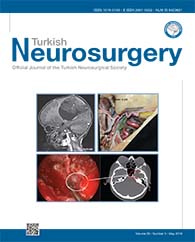2Sichuan University, West China Hospital, Department of Neurosurgery, Chengdu, Sichuan Province, P.R. China DOI : 10.5137/1019-5149.JTN.24369-18.2 AIM: To report the four most common spinal parasites for providing insight into definitive therapy.
MATERIAL and METHODS: Twelve patients with spinal parasites were diagnosed between 2009 and 2016. A definite diagnosis was established in the form of histopathology (n=9) and response to drug therapy (n=3). The minimum follow-up was 0.9 years and ranged to a maximum of 8 years, with a median of 3 years.
RESULTS: Twelve patients aged between 8 and 69 years were reviewed, including nine hydatidosis and three non-hydatid cases. Occupational exposure to the endemic area and unclean food were the main routes of infestation. Spinal parasites can present symptoms that correlated with the level of the lesion. There was complete paraplegia in four patients and paraparesis in six patients before surgery. Seven hydatid patients underwent posterior decompression and pedicle screw fixation with posterolateral fusion. Two non-hydatid patients experienced laminoplasty after posterior decompression. Six hydatid patients had reoccurrences and two patients with intramedullary hydatidosis died of severe complications one year after surgery.
CONCLUSION: Spinal hydatidosis significantly differs from the three other non-hydatid parasites in diagnosis and treatment. The final prognosis of spinal hydatidosis remains poor, especially for intramedullary hydatidosis.
Keywords : Spinal parasite, Hydatid, Differential diagnosis, Treatment




